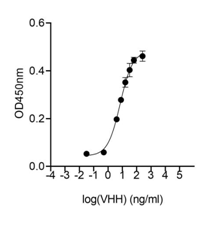Anti-Alkaline Phosphatase Polyclonal Antibody

Figure 1: All Lanes: Anti ALPL(39-2015) at 0.5ug/ml. Lane 1: Human Placenta Tissue Lysate at 50ug, Lane 2: HT1080 Whole Cell Lysate at 40ug, Lane 3: JURKAT Whole Cell Lysate at 40ug. Predicted band size: 57 kDa. Observed band size: 57 kDa.
Roll over image to zoom in
Shipping Info:
For estimated delivery dates, please contact us at [email protected]
| Format : | Lyophilized |
| Amount : | 100 μg/vial |
| Isotype : | Rabbit IgG |
| Purification : | Immunogen affinity purified. |
| Content : | Each vial contains 5mg BSA, 0.9mg NaCl, 0.2mg Na2HPO4, 0.05mg Thimerosal, 0.05mg NaN3. Reconstitute : Add 0.2ml of distilled water will yield a concentration of 500ug/ml. |
| Storage condition : | At -20˚C for one year. After reconstitution, at 4˚C for one month. It can also be aliquotted and stored frozen at -20˚C for a longer time. Avoid repeated freezing and thawing. |
| Gene : | ALPL |
| Gene ID : | 249 |
| Uniprot ID : | P05186 |
| Alternative Name : | Alkaline phosphatase, tissue-nonspecific isozyme; AP-TNAP; TNSALP; 3.1.3.1 ; Alkaline phosphatase liver/bone/kidney isozyme; ALPL |
| Immunogen Information : | A synthetic peptide corresponding to a sequence at the N-terminus of human Alkaline Phosphatase(31-45aa DQAQETLKYALELQK), different from the related mouse and rat sequences by three amino acids. |
Alkaline phosphatase(ALPL) removes phosphate groups from the 5' end of DNA and RNA, and from proteins, at high pH. Most mammals have 4 different isozymes: placental, placental like, intestinal and non tissue specific(found in liver, kidney and bone). Tissues with particularly high concentrations of ALP include the liver, bile ducts, placenta, and bone. ALPL is the alkaline phosphatase of skin fibroblasts,the tissue-nonspecific type, and that it is active toward millimolar concentrations of the putative natural substrates phosphoethanolamine(PEA) and pyridoxal-5-prime-phosphate(PLP). ALPL gene exists in single copy in the haploid genome and is composed of 12 exons distributed over more than 50 kb.Damaged or diseased tissue releases enzymes into the blood, so serum ALP measurements can be abnormal in many conditions, including bone disease and liver disease.
Western blot : 0.1-0.5μg/ml;
For Research Use Only. Not for use in diagnostic/therapeutics procedures.
| Subcellular location: | Cell membrane |
| Post transnational modification: | N-glycosylated. |
| BioGrid: | 106750. 7 interactions. |
|
There are currently no product reviews
|






















.png)











